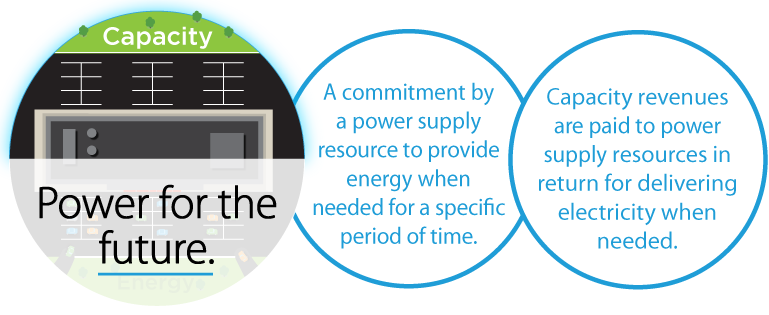Capacity Market (RPM)
Each PJM member that provides electricity to consumers must acquire enough power supply resources to meet demand not only for today and tomorrow but for the future. Members secure these resources for the future through the PJM capacity market.

PJM’s capacity market, called the Reliability Pricing Model, ensures long-term grid reliability by procuring the appropriate amount of power supply resources needed to meet predicted energy demand three years in the future. Under the “pay-for-performance” model, resources must deliver on demand during system emergencies or owe a significant payment for non-performance. Think of this like an insurance policy – for a small additional cost (payment to resources which perform well), consumers will have greater protection from power interruptions and price spikes during weather extremes. By matching power supply with future demand, PJM’s capacity market creates long-term price signals to attract needed investments to ensure adequate power supplies.
Capacity represents a commitment of resources to deliver when needed, particularly in case of a grid emergency. A shopping mall, for example, builds enough parking spaces to be filled at its busiest time – Black Friday. The spaces are there when needed, but they may not be used all year round. Capacity, as it relates to electricity, means there are adequate resources on the grid to ensure that the demand for electricity can be met at all times.
In PJM’s case, that means that a utility or other electricity supplier is required to have the resources to meet its customers’ demand plus a reserve. Suppliers can meet that requirement with generating capacity they own, with capacity they purchase from others under contract, through demand response – in which end-use customers reduce their usage in exchange for payment – or with capacity obtained through PJM capacity-market auctions.
The essential elements of the capacity market are:
- Procurement of capacity three years before it is needed through a competitive auction
- Locational pricing for capacity that varies to reflect limitations on the transmission system
- A variable resource requirement curve, which is the demand formula used to set the price paid to market participants for capacity and the amount of capacity
Capacity market participants offer power supply resources into the market that provide supply or reduce demand. These resources include new and existing generators, upgrades for existing generators, demand response (consumers reducing electricity use in exchange for payment), energy efficiency and transmission upgrades. When a participant offers these resources into the market, that participant is committed to increase supply or reduce demand on the PJM system by the amount they offered, three years in the future.